Egg Shell Quality: Overcoming Production Losses with a Novel Enzyme Activator
Published: January 21, 2008
By: JUAN GOMEZ-BASAURI (Courtesy of Alltech Inc.)
Shell defects are not only of concern to producers and processors but to consumers as well. Recently, a study conducted to determine the quality of eggs at the retail level found that 45% of all cartons examined had at least one cracked egg (Bell et al., 1997). The results of this study would partially (or totally) justify the typical consumer behavior of opening the egg carton to check before purchasing. In addition, the presence of a cracked, or worse, a leaker egg would mean discarding the whole carton to avoid the risk of bacterial contamination, which translates into reduced profit for the supermarket, wholesaler, and ultimately the egg producer.
Considerable research has been done over the past four decades regarding egg shell quality that has helped the layer industry, and much continues to be done. Recently, dietary supplements that activate enzyme systems responsible for shell formation have caught the attention of the industry as a means of overcoming some of the losses associated with poor shell quality (Klecker et al., 1997; Gomez-Basauri, 1997). This chapter will review recent information on that topic.
EGG SHELL FORMATION: A TWO STEP PROCESS
SHELL MEMBRANES
Proper shell formation is very important if one is to achieve profitable egg production. Initiation of egg shell formation takes place within the oviduct starting with shell membrane secretion in the isthmus (Figure 1). Improper synthesis, changes in amino acid composition, or abnormal secretion of the membranes can impair egg shell formation (Table 1, Figure 2) and result in a decline in egg shell quality as the laying cycle progresses (Britton, 1977; Britton and Hale, 1977; Leach, 1982; Fraser, 1996).
These alterations as lay progresses are probably associated with copper and manganese deficiencies (Figure 3) (Lyons, 1939; Baumgartner et al., 1978; Leach and Gross, 1983), possibly due to the roles that these minerals, specifically manganese, play in the synthesis of proteinmucopolysaccharides in the isthmus and the liver (Leach et al., 1969; Eckert et al., 1986; Bakke and Krampitz, 1991). The role of these minerals is likely to be that of cofactors or activators of enzymes (a mucopolysaccharide synthetase) responsible for this process.

Figure 1. The avian oviduct.
Table 1. Shell deformation and age of hens in relation to shell membrane dry weight.

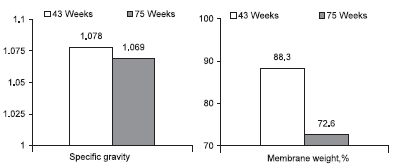
Figure 2. Specific gravity and weight percentages in dried shell membranes of eggs from hens at two ages (adapted from Blake et al., 1985).

Figure 3.Effect of dietary manganese on egg shell thickness and matrix carbohydrate composition (adapted from Leach and Gross, 1983).
SHELL MINERALIZATION
Following the secretion of shell membranes, shell formation or shell mineralization takes place in the shell gland, a process that usually requires 19–20 hours (Austic and Nesheim, 1990). In addition to calcium, carbonate ions in the shell gland fluid in sufficient quantities to form calcium carbonate are necessary for the formation of the egg shell (Austic and Nesheim, 1990). Carbonate ion deficit is usually overlooked as a cause of poor shell quality (Balnave, 1996). One of the major sources of carbonate ions for shell formation is carbon dioxide produced during normal metabolism of the cells in the shell gland or from the blood. It has been indicated that the activity of carbonic anhydrase may play an important role in determining shell quality and that factors that affect activity either way will affect shell quality correspondingly (Balnave et al., 1992; Balnave, 1996). It has been recently shown (Kang et al., 1996) that the activity of this enzyme as well as others is directly related to shell quality (Table 2).
Table 2. Biochemical parameters and shell quality.
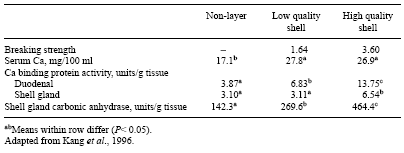
ENZYME ACTIVATION: OVERCOMING EGG SHELL PROBLEMS
EGGSHELL 49: A NOVELACTIVATOR FOR SHELL FORMATION
It is well enough known that enzymes need cofactors and activators in order to function adequately. Trace mineral absorption interference and competition for absorption sites may directly depress the activity of the enzyme systems involved in shell formation. It has been proposed that the use of more bioavailable and bioactive forms of these trace mineral cofactors may help reduce some of the problems associated with poor shell quality (Klecker et al., 1997; Gomez-Basauri, 1997). The increased bioavailability and bioactivity of these organic minerals in enzyme-mediated shell formation processes must be taken into account in order to improve egg shell quality.
Eggshell 49, a commercial supplement developed to address the problem of reduced shell quality, has been shown to improve various shell quality parameters (Klecker et al., 1997; Keshavarz, personal communication) (Figures 4 and 5).
Trends for shell quality within any given flock are influenced by the individuals in such a population (Boorman et al., 1989). In any given flock there will be hens that will lay good shell quality eggs as there will be birds laying poor shell quality eggs. In addition, hens will respond differently to stress situations, and perform better or worse than others. Under these conditions, a greater response to supplementation should be seen with hens that need the most help.
Recent work (Miles, personal communication) has shown that individuals within a flock respond differently to Eggshell 49 depending on whether initial shell quality was classified as good or poor. In an experiment in which individuals in a test flock were ranked as having either good or poor quality shells (based on shell weight), Eggshell 49 supplementation began at 50 weeks of lay. Both groups responded positively to the supplement; however, hens with the poorest egg shell quality responded significantly better (Tables 3 and 4).
The benefits of supplementation with Eggshell 49 were more obvious as the laying cycle advanced. These data confirm commercial results observed with Eggshell 49 supplementation (Figure 6).
The results to date indicate that by maintaining an adequate supply of biologically available cofactors such as those present in Eggshell 49, a decrease in the rate of deterioration of shell quality as lay progresses is achieved. This type of supplementation will then provide a means to overcome production losses.
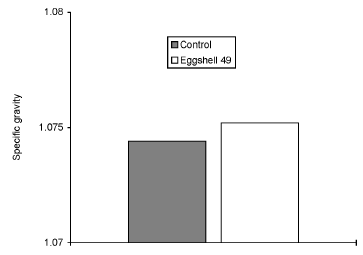
Figure 4.Effect of Eggshell 49 on shell specific gravity (adapted from Keshavarz, personal communication).
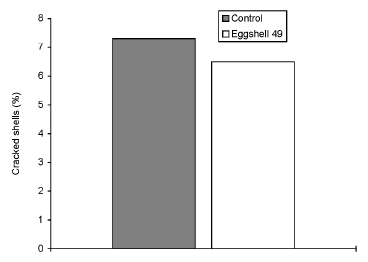
Figure 5.Effect of Eggshell 49 on the percentage of cracked shells (adapted from Keshavarz, personal communication).
Table 3. Effect of Eggshell 49 on egg shell weights (g) from hens having initially good or poor shell quality.

Table 4. Effect of Eggshell 49 on percent shell from hens having initially good or poor shell quality.

SUMMARY
Egg shell quality problems continue to represent a major financial loss to the layer industry. A new approach to help overcome these losses via a nutritional supplement has been proposed. Trace mineral availability plays a significant role in keeping the enzyme systems responsible for shell formation functioning adequately. Eggshell 49, a novel enzyme activator, has been found to be a way to overcome some of the problems associated with poor egg shell quality.
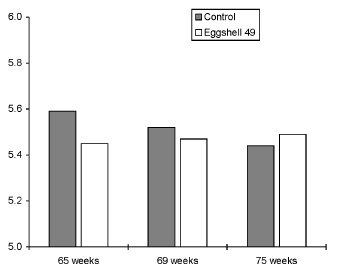
Figure 6. Effect of Eggshell 49 on shell weight (g). (Eggshell 49 group, 18,000 hens; control group, 22,000 hens)
REFERENCES
Anderson, C.B. and T.C. Carter. 1976. The hen’s egg: shell cracking at impact on a heavy, stiff body and factors that affect it. Br. Poultry Sci. 17:613–626.
Austic, R.E. and M.C. Nesheim. 1990. In: Poultry Production. 13th Edition. Lea & Febiger. Philadelphia, London. pp. 47–55.
Bakke, A. and G. Krampitz. 1991. Synthesis of precursor polypeptides of chicken shell membranes in the liver and the isthmus region of the oviduct. Archiv. Fur Geflugelkunde 55:117–120.
Balnave, D. 1996. Carbonate limitation as a cause of poor egg shell quality. In: Arkansas Nutrition Conference, Proceedings of the Meeting. September 10–12.
Balnave, D., N. Usayran El-Khatib and D. Zhang. 1992. Poultry Sci. 71:2035–2040.
Baumgartner, S.G., D.J. Brown, E. Salevsky, Jr. and R.M. Leach, Jr. 1978. Copper deficiency in the laying hens. J. Nutr. 108:804–811.
Bell, D. 1998. Egg shell quality – its impact on production, processing and marketing economics. In: Biotechnology in the Feed Industry. Proceedings of Alltech’s 14th Annual Symposium (Eds. T.P. Lyons and K.A. Jacques), Nottingham University Press, Loughborough, Leics, UK.
Bell, D., P. Patterson, K. Anderson, K. Koelkebeck, J. Carey and M. Darre. 1997. National retail egg quality studies, Part 1: White egg results. Poultry Sci. 76(Suppl. 1):55.
Blake, J.P., L.J. Kling andW.A. Halteman. 1985. The relationship of the amino acid composition of a portion of the outer egg shell membrane to egg shell quality. Poultry Sci. 64:176–182.
Boorman, K.N., J.G. Volynchook and C.G. Belyavin. 1989. Egg shell formation and quality. In: Recent Developments in Poultry Nutrition. Edited by D.J.A. Cole and W. Haresign. Butterworths, London. pp. 261–275.
Britton,W.M. 1977. Shell membranes of eggs differing in shell quality from young and old hens. Poultry Sci. 56:647-653.
Britton,W.M. and K.K. Hale, Jr. 1977. Amino acid analysis of shell membranes of eggs from young and old hens varying in shell quality. Poultry Sci. 56:865–871.
Eckert, J., H. Glock, R. Schade, G. Krampitz, H. Enbergs and J. Petersen. 1986. Synthesis of a precursor polypeptide of egg shell matrix in the liver of the laying hen. J. Anim. Phys. Anim. Nut. 56: 258–265.
Folkerts, J. 1976. Influence of feeding and husbandry on egg shell quality. 5th European Poultry Conference Vol.1:580.
Fraser, A.C. 1996. Environmental and physiological factors affecting the formation of the egg shell of the domestic fowl. PhD Thesis. University of Glasgow.
Gomez-Basauri, J. 1997. Egg shell quality and economic losses: The potential for improvement with dietary trace mineral proteinates. In: Biotechnology in the Feed Industry. Proceedings of Alltech’s 13th Annual Symposium (Eds. T.P. Lyons and K.A. Jacques), Nottingham University Press, Loughborough, Leics, UK. pp. 381–388.
Hamilton, R.M.G., K.G. Hollands, P.W. Voisey and A.A. Grunder. 1979. Relationship between egg shell quality and shell breakage and factors that affect shell breakage in the field. A review. World’s Poultry. Sci. J. 35:177–190.
Kang, C.W., K.T. Nam, O.E. Olson and C.W. Carlson. 1996. Relationships between egg shell quality and biochemical parameters of calcium metabolism. AJAS. 9:715–722.
Klecker, D., L. Zeman, J. Gomez-Basauri.1997. Influence of trace mineral proteinate supplementation in egg shell quality. Poultry Sci. 76 (Suppl.1): 131.
Leach, R.M. Jr. 1982. Biochemistry of the organic matrix of the egg shell, Poultry Sci. 61:2040–2047.
Leach, R.M. Jr. and R. Gross. 1983. The effect of manganese deficiency upon the ultrastructure of the egg shell. Poultry Sci. 62:499–504.
Leach, R.M. Jr., A.M. Muenstert, and E.M. Wein. 1969. Studies of the role of manganese in bone formation. II. Effect upon choindroitin sulfate synthesis in chick epiphyseal cartilage. Arch. Biochem. Biophys. 133:22–28.
Lyons, M. 1939. Some effects of manganese on egg shell quality. Bull 374, Arkansas Agric. Exp. Stn.
Roland, D.A. Sr. 1977. Incidence of uncollectable eggs. Poultry Sci. 56:1327–1328.
Roland, D.A. Sr. 1988. Research note: egg shell problems: estimates of incidence and economic impact. Poultry Sci. 67:1801–1803.
Author: JUAN GOMEZ-BASAURI
Alltech Inc., Nicholasville, Kentucky, USA
Related topics
Join to be able to comment.
Once you join Engormix, you will be able to participate in all content and forums.
* Required information
Would you like to discuss another topic? Create a new post to engage with experts in the community.
Create a post






.jpg&w=3840&q=75)